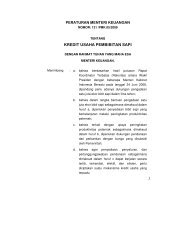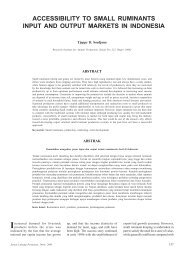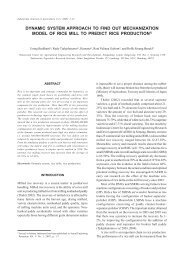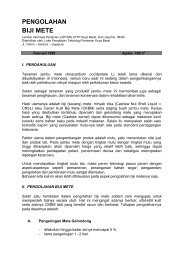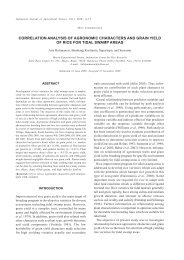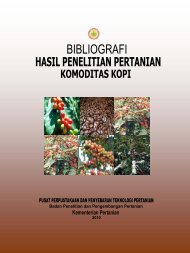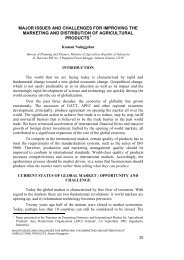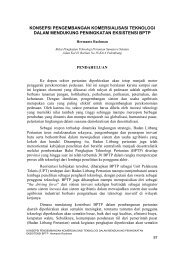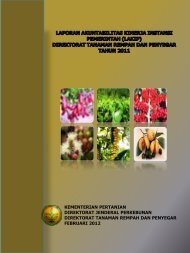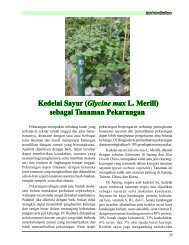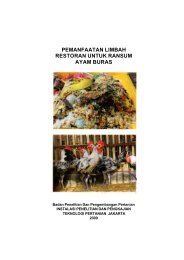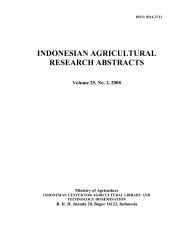LABORATORY AND FIELD EVALUATION OF ESSENTIAL OILS ...
LABORATORY AND FIELD EVALUATION OF ESSENTIAL OILS ...
LABORATORY AND FIELD EVALUATION OF ESSENTIAL OILS ...
Create successful ePaper yourself
Turn your PDF publications into a flip-book with our unique Google optimized e-Paper software.
Laboratory Indonesian and Journal field evaluation of Agricultural of essential Science oils 12(1), from Cymbopogon 2011: 9-16 nardus ... 9<strong>LABORATORY</strong> <strong>AND</strong> <strong>FIELD</strong> <strong>EVALUATION</strong> <strong>OF</strong> <strong>ESSENTIAL</strong> <strong>OILS</strong> FROMCymbopogon nardus AS OVIPOSITION DETERRENT <strong>AND</strong> OVICIDAL ACTIVITIESAGAINST Helicoverpa armigera Hubner ON CHILI PEPPERWiwin Setiawati *) , Rini Murtiningsih, and Ahsol HasyimIndonesian Vegetables Research InstituteJalan Tangkuban Perahu No. 517, Lembang, PO Box 8413 Bandung 40391, IndonesiaPhone +62 22 2786245, Fax +62 22 2786416, Email: balitsa@litbang. deptan. go.id*)Corresponding author: wsetiawati@yahoo.comSubmitted 23 September 2010; Accepted 27 January 2011ABSTRACTThe fruit borer (Helicoverpa armigera Hubner) is one of thekey pests of chili pepper in Indonesia. Yield loss due to thisinsect pest may reach up to 60%. Chemical treatment for controllingthis insect pest is ineffective and eventually leads toenvironmental pollution. More environmentally safe insecticidesare developed based on natural plant ingredients as their activecompound such as essential oils. This study aimed to assess thepotential of citronella oil for managing H. armigera on chilipepper. The experiments were conducted at the IndonesianVegetables Research Institute from April 2009 to March 2010and in Cirebon, West Java from November 2009 to March2010. A field experiment was designed in a randomized completeblock design with five treatments and replicated five times.Citronella oil was extracted by steam distillation from Cymbopogonnardus. The oil was then chemically characterized byusing GC-MS and its efficacy (ovicidal and feeding deterrent)against H. armigera was tested both in laboratory and fieldconditions. The GC-MS result showed that major chemicalcompounds of the citronella oil used were citronella (35.97%),nerol (17.28%), citronellol (10.03%), geranyle acetate (4.44%),elemol (4.38%), limonene (3.98%), and citronnellyle acetate(3.51%). The laboratory experiment revealed that the highestconcentration (4,000 ppm) of citronella oil reduced egg layingby 53-66%. Ovicidal activity was concentration dependent, andegg hatchability decreased by 15-95% compared to control.The field experiment showed that treatment of citronella oilat 2.0 mL L -1 significantly reduced fruit damage by H. armigerasimilar to the plots treated with spinosad at the recommendeddose (60 g ai ha -1 ). Application of citronella oil significantlyreduced fruit damage by 72% and increased quality of the chilipepper. Because oviposition and feeding deterrent propertiesare key factors in controlling the pest, therefore this studyrevealed that citronella oil has potential to be incorporated intothe controlling program of H. armigera on chili pepper.[Keywords: Capsicum annuum, Cymbopogon nardus, Helicoverpaarmigera, oviposition deterrent, ovicidal activities]INTRODUCTIONChili pepper is an important vegetable crop inIndonesia since it is grown year-round. It is cultivatedmainly by small farmers both in highland andlowland areas under rainfed as well as irrigated conditions.In 2008, total planted areas of chili pepper was109,178 ha producing 695,707 t of fresh fruit with anaverage yield of 6.37 t ha -1 (Statistics Indonesia 2009).A wide range of insects attack chili pepper andcauses significant yield loss. Among the pests, fruitborer (Helicoverpa armigera Hubner) is the mostdestructive insect pest, not only on chili pepper butalso in other vegetable crops, especially during thedry season. H. armigera caused yield loss of chilipepper up to 60% (Luther et al. 2007). The pest isdifficult to be eradicated because it has many alternativehost plants, such as tobacco, maize, sorghum,cotton, potato, okra, cabbage, green peas, chrysanthemum,tomato, carrot, lettuce, eggplants, and otherhorticultural crops (Kalshoven 1981).Most of farmers applied synthetic chemical insecticidesto control insect pests on chili pepper. Somefarmers mixed different types of synthetic insecticidesto get satisfied control level of the pests. Number ofspray application during a season was around 21times (Adiyoga 2007). Despite its high insecticideuse, the average yield loss due to insects is still high.Study in some countries indicated that H. armigera isresistant to major conventional groups of pesticides,such as pyrethroids, organophosphates, organochlorines,and carbamates (Ahmad et al. 1997; Ahmadet al. 2001; Torres-Vila et al. 2002; Ramasubramanianand Regupathy 2004; Ahmad 2007; Chaturvedi 2007).Many plant essential oils show a broad spectrum ofactivities against insect pests and plant pathogenicfungi ranging from insecticidal, antifeedant, repellent,oviposition deterrent, growth regulatory, and antivectoractivities. These essential oils are, therefore,potential to be used as an alternative pesticides forcontrolling insect pests. Cost-effective, safe, andecologically-sound strategies for controlling thesepests are essential to maintain production efficiencyand quality.
10 Wiwin Setiawati et al.Recently, scientists have become more interested inthe utilization of plant materials as environmentallyfriendlybotanical pesticides because they oftenminimize the adverse effects on beneficial insects,reduce the need for prohibitively expensive chemicals,reduce the development of resistance, and are lesspolluting the environment. Among these botanicalpesticides, citronella oil has been most extensivelystudied in the last decades. The efficacy of citronellaoil against various insect species has been noted asa repellent, an antifeedant, and an oviposition deterrent.Some studies indicated that citronella oil iseffective in repelling mosquito Aedes aegypti (Jantanand Zaki 1999), Spodoptera frugiperda (Labinas andCrocomo 2002), and as antifungal and antibacterial(Nakahara et al. 2003; Pattnaik et al. 2006). Citronellaoil is extracted from Cymbopogon nardus (also knownas Andropogon nardus) of the Gramineae (Poaceae)family. Citronellal, trans-geraniol, carvone, and limonenewere active compounds as anti-microbial (Simicet al. 2008), citronellal and linalool as an antifungal(Nakahara et al. 2003), whereas menthone, transgeraniol,and citronellal showed a strong inhibitoryeffect (JIRCAS 2005). The present study aimed toevaluate the potential of citronella oil for ovipositiondeterrence and ovicidal activity against H. armigeraon chili pepper.MATERIALS <strong>AND</strong> METHODSH. armigera larvae were collected from chili pepper inLembang District, West Java, Indonesia. The larvaewere then reared in the laboratory of the IndonesianVegetables Research Institute (IVEGRI). Late larvaewere separated to cannibalism sites. Emerging adultmoths were transferred to cages at a ratio of 1:1 andfed on a 10% sucrose solution for oviposition. Thecage was then covered with paper towel for egglaying. The paper towel containing eggs was removeddaily then moistened and kept in plastic containers toallow hatching. One day-old adults were used foroviposition deterrent activity. All experiments andmass rearing were carried out at ambient temperature(27°C ± 2°C).C. nardus leaves were collected in April and May2009 from a field experiment of IVEGRI. The leaveswere transported in plastic bags to the laboratorywhere they were put to dry at room temperature(28°C) on the same day. After 4 days, the leaves werechopped before extraction. The plant was identifiedand authenticated by a plant taxonomist.For plant extraction, a simple laboratory quick fitapparatus with 2,000 mL steam generator flask, adistilling flask, a condenser, and a receiving vesselwere used for steam distillation. The flask was heatedwith a gas burner. One hundred grams of air dried andchopped leaves of C. nardus were subjected to steamdistillation.Coupled gas chromatography mass spectrometry(GC-MS) was performed on a Hewlett Packard 5973mass selective detector (70 Ev), coupled to a HewlettPackard gas chromatograph equipped with a split/splitless Programmed Temperature Vaporization (PTV)injection system (CIS 4: Gerstel, Mûlheim an der Ruhr,Germany). Injections were done in split mode only (1µL). The column was a 30 m EC-5 fused silica column,0.25 mm ID, and 0.25 µm film thickness (Alltech/Applied Science BV., Breda, the Netherlands). Conditionswere: carrier gas, helium, constant head pressureat 0.6 bar; temperature programming at 50°C for 2minute hold to 300°C for 5 minute hold at 8°C min -1 ,injector temperature at 250°C, and transfer line temperatureat 300°C.The efficiency of the citronella oil at different concentrationswas determined in IVEGRI laboratoryfrom June to October 2009. For choice test, five potswere sprayed with one of the tested citronella oilconcentrations (4,000, 3,000, 2,000, and 1,000 ppmplus 0.05% of Tween 20) using a hand sprayer of 1 Lcapacity. Another five pots were sprayed with waterand emulsifier (Tween 20) as an untreated check. Thepots (four treated + check in random) were thenplaced in a wooden cage (100 cm x 100 cm x 100 cm)and covered with a screen. For no-choice test, fivepots were sprayed with one of the tested citronella oilconcentrations (4,000, 3,000, 2,000, and 1,000 ppm)using a hand sprayer of 1 L capacity. Another fivepots were sprayed with water and emulsifier as anuntreated check. Five pots of each treatment wereplaced in a wooden cage (100 cm x 100 cm x 100 cm),respectively.Ten pairs of emerged moths were introduced intothe cage with the sprayed hot pepper potted plantsand the control. Each test was replicated five times.The experiment was laid out in randomized completeblock design (RCBD). The number of eggs depositedon treated or untreated plants was counted daily fromeach test. The percent effective repellency for eachleaf extract concentration was calculated using thefollowing formula:NC - NTER (%) = ————— x 100 (%)NC
Laboratory and field evaluation of essential oils from Cymbopogon nardus ... 11WhereER = percent effective repellencyNC = number of eggs in controlNT = number of eggs in treatment.Ovicidal activity was evaluated by exposing 20eggs of H. armigera to five concentrations of citronellaoil (4,000, 3,000, 2,000, 1,000 ppm and 0 ppm plus0.05% of Tween 20) and allowed to hatch. Theexperiment was carried out with five treatments in fivereplications using RCBD.Field experiment was carried out at a farmer’s fieldat Pabedilan Village in Cirebon, West Java, fromNovember 2009 to March 2010. Plot size was 60 m 2 .Each treatment consisted of 400 plants. The experimentwas designed in a RCBD with five treatments,including one untreated plot, and replicated fivetimes. The treatments consisted of citronella oil (2.0mL L -1 ), spinosad at recommended dose (60 g ai ha -1 ),citronella oil (2.0 mL L -1 ) alternated weekly withspinosad at recommended dose (60 g ai ha -1 ), conventionalcontrol (imidacloprid 200 g L -1 + fenitrothion500 g L -1 ), and untreated control treatment. Applicationsof all treatments were done eight times duringthe experiment with one-week interval between applications.Data on fruit quality (percentage of damagedfruits or percentage of unmarketable fruits) and yield(undamaged or marketable fruits) were evaluated ateach harvest.The data were analyzed using Genstat for Windows11 th edition. The comparison of means was doneusing Duncan's multiple range test at 0.05 level.RESULTS <strong>AND</strong> DISCUSSIONChemical Composition of Essential OilsGC-trace and chemical composition of essential oilsof C. nardus are presented in Figure 1 and Table 1.The major chemical compounds were citronella(35.97%), nerol (17.28%), citronellol (10.03%),geranyle acetate (4.44%), elemol (4.38%), limonene(3.98%), and citronnellyle acetate (3.51%). Thecomposition of essential oils resulted in this studywas significantly different from that previouslyreported by Mahalwal and Ali (2003). The majorcomponents of essential oils from C. nardus cultivatedin India were citronellal (29.7%), geraniol (24.2%),terpineol (9.2%), and cissabinene hydrate. It wasreported that the citronellal content varied among thecultivated citronella varieties. Citronella oil from SriLanka contained 40.5-60.7% of citronellal, whereasthat from India contained much smaller amounts ofcitronellal, i.e. 17.2-33.2% (Mahalwal and Ali 2003).Additionally, the composition of essential oils isaffected by many factors, including the cultivationconditions of the plants and isolation techniques(Janssen et al. 1987). The other constituents of C.nardus Mahapengiri variety at 6 months after plantingare given in Table 1.Oviposition DeterrentIn laboratory oviposition deterrent tests, citronella oilconcentrations greatly reduced the number of eggsAbundance9e+078e+079.92TIC: 1001010.D7e+076e+0722.125e+074e+073.8219.393e+072e+0715.6218.8028.971e+073.396.5012.9510.3312.0812.19 12.4616.56 18.3217... 18.2416.00 17.20 20.36 22.8227.8731.25 32.52 33.7530.7935.3838.174.00 6.00 8.00 10.00 12.00 14.00 16.00 18.00 20.00 22.00 24.00 26.00 28.00 30.00 32.00 34.00 36.00 38.00 40.00 42.00 44.00 46.00 48.00 50.00TimeFig. 1. GC- trace of Cymbopogon nardus.
12 Wiwin Setiawati et al.Table 1. Chemical compositions of essential oils of Cymbopogonnardus.ComponentsRelative percentage(%)Beta-myrcene 0.10Limonene 3.982.6-dimetil-5-heptenal 0.44Citronella 35.97Citronella 0.18Linalool 0.64Isopulegol 0.44(-)-isopulegol 0.90Beta-elemene 1.80Citronnellyle acetate 3.51Z-citral 0.59Germacrene D 1.52Delta δ guaiena 0.21Geraniol formate 0.21Alfa α muurolena 0.49Citral 1.01Bisiklo (4.4.0) dec-1-en, 2 isoprophy 0.96Delta δ cadinena 1.76Geranyle acetate 4.44Citronellol 10.03Nerol 0.20Nerol 17.285-nitrobenzofuran -2-carboksil acid 0.15Endo-1-bourbonanol 1.28Elemol 4.38Patchouli alcohol 0.99Beta-patchoulena 0.39Alfa-cadinol 0.54Eugenol 1.29T-muroolol 0.56Alfa-copaena 0.06Alfa-eudesmol 0.37Beta-eudesmol 0.39T. cadinol 1.24Siklobutene, 1,2,3,4-tetrametil 1.41Geranil linalool isomer 0.167-acetil-2-hidroksi-2-metil 0.13layed by H. armigera (Table 2 and 3). In no-choicetest, the egg laying capacity gradually decreasedwith the increase in citronella oil concentration level.The maximum reduction in egg laying was noticed intreatment of essential oil concentration of 4,000 ppmwhere only 73 eggs were laid by H. armigera on thetreated plant as against 152 eggs in the control. Therewas no significant difference in the number of eggslaid by the female of H. armigera on the plants ofvarying treatments in the choice test. Choice and nochoicetests revealed that highest concentrations ofcitronella oil reduced egg laying by 53-66%. Lowerconcentrations also had deterrent activity both in nochoiceand choice tests.Table 2. Oviposition deterrent activity of essential oil(citronella) of Cymbopogon nardus on female Helicoverpaarmigera in a no-choice treatment.Concentration Number Effective repellency(ppm) of eggs (%)4,000 73.0d 533,000 95.2c 382,000 97.2c 331,000 113.4b 260 (untreated) 152.4a -Means followed by the same letters are not significantly differentaccording to DMRT at α = 0.05.Table 3. Oviposition deterrent activity of essential oil(citronella) of Cymbopogon nardus on female Helicoverpaarmigera in choice treatment.Concentration Number Effective repellency(ppm) of eggs (%)4,000 154.0a 663,000 178.2b 612,000 180.8b 601,000 184.8b 600 (untreated) 452.0b -Means followed by the same letters are not significantly differentaccording to DMRT at α = 0.05.The potential of plant essential oils as a source ofinsecticide has been worked out and reported withreference to various pests. Aerts and Mordue (1977),working with triterpenoids extracted from Azadirachtaindica, verified high deterrent activity on Spodopteralittoralis larvae and Schistocerna gregaria nymphs.Rosemary oil was effective against certain insect andmite (Papachristos and Stampoulos 2004) and Ocimumamericanum essential oil was effective on Agrotisipsilon (Sadia et al. 2007).The result of our study showed that essential oilsfrom C. nardus were effective against H. armigera.These findings are in accordance with Paranagama etal. (2003, 2004) who found that citronella oil waseffective against Callosobruchus maculatus andSitophilus oryzae.The effect of citronella oil on the oviposition preferenceof H. armigera within the treatments showeda similar pattern. These results have confirmed thatthe use of essential oils did not affect the ovipositionpreference of H. armigera where eggs were distributedover all parts of chili plants in both choiceand no-choice test (Fig. 2 and 3). However, leaveswere more preferred by H. armigera for ovipositionthan other plant parts, with 60-98% of the total eggswere laid on leaves compared to stem, flower, and
Laboratory and field evaluation of essential oils from Cymbopogon nardus ... 13No. of eggs140120LeafStemFlowerFruit100806040200-201,000 2,000 3,000 4,000 ControlEssential oil of C. nardus (ppm)Fig 2. Effect of citronella oil concentration on distribution of Helicoverpa armigera eggs laid on chili pepper plant (mean ±SE) in a no-choice treatment.No. of eggs300250LeafStemFlowerFruit2001501005001,000 2,000 3,000 4,000 ControlEssential oil of C. nardus (ppm)Fig 3. Effect of citronella oil concentration on distribution of Helicoverpa armigera eggs laid on chili pepper plant (mean ±SE) in a choice treatment.fruit. A similar result was observed in all treatments.Jallow et al. (2001) reported that female H. armigerapreferred to lay its eggs on leaves of tomato, maize,okra, and pepper, whereas on eggplant the insectpreferred flowers and fruits. Shape, color, texture,size, and chemical composition of these plants mayinfluence oviposition preference (Courtney andKibota 1990). Thomson (1987) and Javed et al. (2009)stated that the females prefer to lay eggs on plantparts with high trichome density and high concentrationof stimulatory chemicals.The result of ovicidal assay is illustrated in Table 4.The data show that ovicidal activity was concentrationdependent. Citronella oil concentrations of 2,000ppm, 3,000 ppm, and 4,000 ppm decreased egghatchability by 15-95% compared to the control. The
14 Wiwin Setiawati et al.Table 4. Effect of citronella oil concentration on the eggviability of Helicoverpa armigera.Concentration Egg viability Reduction(ppm) (%) (%)4,000 5.0d 953,000 40.0c 602,000 85.0b 151,000 100.0a 00 (control) 100.0a -Means followed by the same letters are not significantly differentaccording to DMRT at α = 0.05.observed mortality from the lower concentrations wascomparable to the control. The finding of the presentexperiment revealed that citronella oil possessesoviposition deterrent and ovicidal activities againstH. armigera. The toxic effect of this oil could beattributed to major constituents such as citronella,linalool, and geranyle acetate. High toxicity of thesecompounds was reported against the rice weevilSitophilus oryzae and Rhyzopertha dominica (Rozmanet al. 2007). Boeke et al. (2004) reported that thevolatile oils of C. nardus caused most of the eggs notto develop into adult (abnormality in egg developmentto adult). The chemical composition and broadspectrum of biological activity of essential oils canvary with plant age, plant tissue, geographical originof plant, organ used in distillation process, type ofdistillation, and species and age of targeted pestorganism (Janssen et al. 1987; Chiasson et al. 2001).Field Evaluation of Citronella OilField observation showed that five insect pestspecies were found in chili pepper plots throughoutthe growing season, i.e. thrips (Thrips parvispinus),Empoasca sp., whitefly (Bemisia tabaci), fruit fly(Bactrocera dorsalis), and fruit worm (H. armigera).However, repellence effects were observed only for H.armigera. At the initial growing period, there was nophytotoxicity symptoms appeared on chilli pepperplants treated with citronella oil, therefore the oil issafe to the plant.The highest and statistically similar reduction offruit damage was observed in plots treated withspinosad insecticide alone (10.39%) and with citronellaoil alone (13.45%). However, when citronella oilwas applied alternately with spinosad, its efficacywas not as high as expected. This indicates thatweekly alternate application of citronella oil withspinosad had some antagonistic effect against H.armigera. Therefore, conventional control by usingsynthetic insecticide alone proved to be the least effective.The reduction of fruit damage over untreatedcontrol ranged from 54.70% to 78.92%. The highestpercent reduction of fruit damage was recorded withspinosad (78.92%) followed by citronella oil (72.71%)(Table 5).Treatment of the citronella oil on chili pepper plantsignificantly affected yields (Table 5). The conventionalcontrol had an average yield of 6.54 t ha -1 andthe citronella oil treatment yielded an average of 7.15-10.90 t ha -1 . The results demonstrated that the use ofcitronella oil reduced fruit damage by H. armigera aswell as increased yields.Efficacy of citronella oil against H. armigera did notsignificantly differ from spinosad insecticide atrecommended dose (60 g ai ha -1 ). Spinosad is a fermentationby-product based compound derived from anaturally occurring soil actinomyces bactsporaerium(Saccharopolyspora spinosa) and is a mixture ofspinosyn A and spinosyn D (Thompson et al. 1997).As reported, spinosad has two unique modes ofaction, i.e. acting primarily on the insect’s nervousTable 5. Fruit damage and yield of chili pepper treated with citronella oil, Cirebon, West Java, 2009-2010.Fruit damageYieldTreatment infested by H. armigera(%) kg plot -1 t ha -1Citronella oil (2 mL L -1 ) 13.45cd 65.39a 10.90Spinosad (60 g ai ha -1 ) 10.39d 51.67b 8.61Citronella oil (2 mL L -1 ) applied alternatelywith spinosad (60 g ai ha -1 ) 16.37c 42.88c 7.15Conventional control (imidacloprid 200 g L -1+ fenitrothion 500 g L -1 ) 22.33b 39.26c 6.54Control (untreated plot) 49.29a 23.98d 4.00Means followed by the same letters within the same column are not significantly different according to DMRT at α = 0.05.
Laboratory and field evaluation of essential oils from Cymbopogon nardus ... 15system at the nicotinic acetylcholine receptor, andexhibiting activity at GABA receptor (Salgado 1997).Spinosad has relatively broad-spectrum activities,and has been effectively used for controlling manyspecies of insect pests, such as S. litura, H. armigera,and T. parvispinus (Setiawati 2009).CONCLUSIONChoice and no-choice tests revealed that the highestconcentration of citronella oil reduced egg laying ofH. armigera by 53-66%. The oil also set as ovicidalwhich decreased egg hatchability up to 95% comparedto control. Eggs were distributed over all plantparts of chili pepper in both choice and no-choicetest, however, leaves were more preferred by H.armigera for oviposition than other plant parts, with60-98% of the total eggs were laid on leaves comparedwith stem, flower, and fruit. The use of citronella oilalone reduced fruit damage by H. armigera, thereforeno synthetic insecticide is required. This indicatesthat citronella oil can be incorporated in pest controlprogram for chili pepper without adversely affectingyield or fruit quality compared with conventionalcontrol based on using synthetic insecticide.ACKNOWLEDGMENTSWe deeply thank to Dr. Paul Ferrar from Australia whogave comment and corrected English grammar of themanuscript. We also thank the Ministry of Agricultureand Ministry of National Education of Indonesiafor funding this research through the SINTA program.REFERENCESAerts, R.J. and A.J. Mordue. 1977. Feeding deterrence and toxicityof neem triterpenoids. J. Chem. Ecol. 23: 2116-2132.Adiyoga, W. 2007. Overview of production, consumption anddistribution aspects of hot pepper in Indonesia. Annual Report.Indonesian Vegetables Research Institute, Lembang, West Java.Ahmad, M., M.I. Arif, and M.R. Attique. 1997. Pyrethroidresistance of Helicoverpa armigera (Lepidoptera: Noctuidae)in Pakistan. Bull. Entomol. Res. 87: 343-347.Ahmad, M., M.I. Arif, and Z. Ahmad. 2001. Resistance tocarbamate insecticides in Helicoverpa armigera (Lepidoptera:Noctuidae) in Pakistan. Crop Prot. 20: 427-432.Ahmad, M. 2007. Insecticide resistance mechanisms and theirmanagement in Helicoverpa armigera (Hübner), A review. J.Agric. Res. 45(4): 319-335.Boeke, S.J., C. Barnaud, J.A.J. van Loon, D.K. Kossou, A. vanHuis, and M. Dicke. 2004. Efficacy of plant extracts againstthe cowpea beetle, Callosobruchus maculatus. Int. J. Pest Mgmt.50(4): 251-258.Chaturvedi, I. 2007. Status of insecticide resistance in the cottonboll worm, Helicoverpa armigera (Hubner). J. Cent. Eur. Agric.8(2): 171-182.Chiasson, H., A. Belanger, A. Bostaniah, C. Vincent, and A.Poliquin. 2001. Acaricidal properties of Artemisia abinthiumand Tanacetum vulgare (Asteraceae) essential oil obtained bythree methods of extraction. J. Econ. Entomol. 19: 167-171.Courtney, S.P. and T.T. Kibota. 1990. Mother doesn’t know best:Selection of host by ovipositing insects. p. 161-188. In E.A.Bernays (Ed.). Insect-Plant Interactions. CRC Press Inc., BocaRaton, Florida, USA.Jantan, I. and Z.M. Zaki. 1999. Evaluation of smoke frommosquito coils containing Malaysian plants against Aedesaegypti. Fitoterapia 70: 237-243.Jallow, M.F., M. Matsumura, and Y. Suzuki. 2001. Ovipositionpreference and reproductive performance of JapaneseHelicoverpa armigera (Hubner) (Lepidoptera: Noctuidae). Appl.Entomol. Zool. 36(4): 419-426.Janssen, A.M., J.J. Schaffer, and A.B. Svendsen. 1987. Antimicrobialactivity of essential oils: A 1976-1986 literature review. Aspectsof the Test Methods. Planta Medica 53: 395-398.Javed, H., M.A. Aziz, and R.A.K. Leghari. 2009. Resistance indifferent okra cultivars (Abelmoschus esculentus L.) againstAmerican bollworm (Helicoverpa armigera Hub.). J. Agric.Res. 47(4): 433-438.JIRCAS 2005. Prevention of postharvest pests using aromaticplants growing in the tropics. JIRCAS Newsl. No. 43, 3 p.Kalshoven, L.G.E. 1981. The Pest of Crops in Indonesia. IkhtiarBaru, Van Hoeve, Jakarta. 701 pp.Labinas, M.A. and W.B. Crocomo. 2002. Effect of Java grass(Cymbopogon winterianus Jowitt) essential oil on fall armywormSpodoptera frugiperda (J.E. Smith. 1797) (Lepidoptera,Noctuidae). Maringa 24(5): 1401-1405.Luther, G., M. Palada, T.C. Wang, A. Dibyantoro, J. Maryono,M. Ameriana, Sutoyo, and D. Bimantoro. 2007. Chilli integrateddeseases management rapid rural appraisal in Central Java,Indonesia. AVRDC-the World Vegetable Center. 61 pp.Mahalwal, V.S. and M. Ali. 2003. Volatile constituents ofCymbopogon nardus (Linn.) Rendle. Flavour Fragrance J. 18:73-76.Nakahara, K., N.S. Alzoreky, T. Yoshihashi, H.T.T. Nguyen, andG. Trakoontivakorn. 2003. Chemical composition and antifungalactivity of essential oil from Cymbopogon nardus (citronellagrass). JARQ 37(4): 249-252.Papachristos, D.P. and D.C. Stampoulus. 2004. Fumigant toxicityof three essential oils on eggs of Acanthoscelides obtectus (Say)(Coleoptera: Bruchidae). J. Stored Prod. Res. 40: 517-525.Paranagama, P., C. Adhikari, K. Abeywickrama, and P. Bandara.2003. Deterrent effects of some Sri Lanka essential oils onoviposition and progeny production of the cowpea bruchid,Callosobruchus maculatus (F.) (Coleoptera; Bruchidae). J. FoodAgric. Environ. 1(2): 254-257.Paranagama, P.A., K.H.T. Abeysekera, L. Nugaliyadde, and K.P.Abeywickrama. 2004. Repellency and toxicity of four essentialoils to Sitophilus oryzae L. (Coleoptera: Cureulionidae). J. Natl.Sci. Foundation Sri Lanka 32(3&4): 127-138.Pattnaik, S., V.R. Subramanyam, and C. Kole. 2006. Antibacterialand antifungal activity of ten essential oils in vitro. Microbios86: 237-246.
16 Wiwin Setiawati et al.Ramasubramanian, T. and A. Regupathy. 2004. Magnitude andmechanism of insecticide resistance in Helicoverpa armigeraHub. population of Tamil Nadu, India. Asian J. Plant Sci. 3: 94-100.Rozman, V., I. Kalinovic, and Z. Korunic. 2007. Toxicity ofnaturally occurring compounds of lamiaceae and lauraceae tothree stored-product insects. J. Stored Prod. Res. 43: 349-355.Sadia, E., A. El-Aziz, E.A. Omer, and A.S. Sabra. 2007. Chemicalcomposition of Ocimum americanum essential oil and itsbiological effects against Agrotis ipsilon (Lepidoptera:Noctuidae). Res. J. Agric. Biol. Sci. 3(6): 740-747.Salgado, V.L. 1997. The modes of action of spinosad and otherinsect control products. Down to Earth 52(1): 35-43.Setiawati, W. 2009. Toxicity of spinoteram and spinosad onSpodoptera litura, Helicoverpa armigera and Thripsparvispinus. Annual Report. Indonesian Vegetables ResearchInstitute, Lembang, West Java.Simic, A., A. Rancic, M.D. Sokovic, M. Ristic, G. Jovanovic, J.Vukojevic, and P.D. Marin. 2008. Essential oil composition ofCymbopogon winterianus. and Carum carvi and theirantimicrobial activities. Pharm. Biol. 46(6): 437-441.Statistics Indonesia. 2009. Horticulture: Area, Production andProductivity of Chilli in Indonesia. http://www.bps.go.id/aboutus.php?tabel=1&id_subyek=55. [09 April 2010].Thomson, N.J. 1987. Host plant resistance in cotton. Aust. J.Agric. Sci. 53: 262-270.Thompson, G.D., H.H. Michel, R.C. Yao, J.S. Mynderse, C.T.Mosburg, T.V. Wordsen, E.H. Chio, T.C. Sparks, and S.H. Hutchins.1997. The discovery of Saccharopolyspora spinosa and a newclass of insect control products. Down to Earth 21(1): 1-5.Torres-Vila, R.M., M.C. Rodríguez-Molina, A. Lacasa-Plasencia,and P. Bielza-Lino. 2002. Insecticide resistance of Helicoverpaarmigera to endosulfan, carbamates and organophosphates:the Spanish case. Crop Prot. 21(10): 1003-1013.



